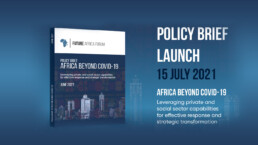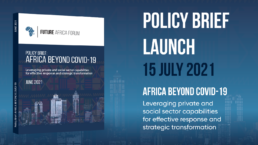Share
COVID-19 will definitely change the way we commute, and we are yet to fully understand what the long-term impact on mobility will be. What is certain, however, is that there will be a sharper focus on how we can make urban transportation more sustainable.
The focus of UN Sustainable Development Goal Number 9 is “Build resilient infrastructure, promote inclusive and sustainable industrialization and foster innovation”. One of the main aims is to promote efficient transportation services as a key driver of economic development.
Under-developed infrastructure remains a huge obstacle for development in many parts of Africa; coupled with a lack of urban planning and an accelerating rural to urban migration, the continent needs innovative and sustainable solutions, and fast.
Emerging transport innovations have proven vital in the current health crisis. We have seen drones being deployed to spray disinfectants, monitor social distancing, and assist law enforcement in enforcing lockdown measures. In some cities, the use of crowded modes of public transport has been discouraged, in favour of bicycles or electric scooters. This has been achieved by converting roads into bicycle lanes. Policy makers have also come on board by allowing flexibility to regulations, enabling some of these emerging innovations to take a leading role in the battle against COVID-19.
Looking at the above examples, it is abundantly clear that a paradigm shift is here. But how, and to what extent will it alter the way we move? Most importantly, will mobility be more sustainable?
Data Analytics to monitor volumes
Data analytics has helped track the movement of people, helping predict areas of potential outbreaks. Google has started publishing location data from users in 131 countries, so governments can evaluate how effective their confinement and physical distancing measures have been to fight the spread of the Covid-19 coronavirus.
The travel industry generates huge volumes of data. For example, travel technology provider, Amadeus processes more than 1 billion transactions daily in its data centres.
Data Analytics will become increasingly useful to understand the impact our transport networks have on the world around us. It is estimated that traffic jams cost the global economy $1.4 trillion annually, according to a report by Here. This amount will inevitably continue to increase, along with carbon dioxide emissions.
Cities will be able to utilize collated location data to predict potential traffic jams. Using predictive analytics, accurate forecasts for public transport demand can be made and capacity can be adjusted accordingly.
Major urban centres such as Lagos and Nairobi, which have millions of commuters moving on a daily basis, can carry out real time impact assessments, in the event of unforeseen disruptions to the transport network. We can predict how many commuters are affected and what remedial measures ought to be taken. We must bear in mind that for any data analytics project to be successful, agile decision making, transparency and open communication are extremely vital.
The rise of Mobility as a Service (MaaS)
Mobility as a Service (MaaS) is the integration of various forms of transport services into a single mobility service accessible on demand. To meet a customer’s request, a MaaS operator facilitates a diverse menu of transport options- be they public transport, ride, car or bike-sharing, taxi or car rental, or a combination thereof. MaaS aims to provide alternatives to the use of private vehicles that are cheaper, convenient, sustainable, and mitigate constraints in transport. MaaS will help supplement current public transport offerings, as well as provide flexible and affordable transport options. A popular example of MaaS is ridesharing platform Uber. But in recent years there has been a rise in indigenous ride sharing services which are jostling with Uber for market share. AfricaCab from Ivory Coast and Kenyan based Little Cab are making significant strides in their respective local markets. The distinct advantage the indigenous platforms have over Uber is their willingness to accept local payment methods like M-Pesa.
Micromobility
Although micromobilty is not entirely new, COVID-19 may have cemented it as the future of urban mobility. Commuters may be reluctant to utilize crowded public buses and single-occupant vehicles. According to a report by OECD, global demand for public transport will double by 2050, and thus, so will CO2 emissions. Micromobility provides a more environmentally sustainable and less congested alternative for commuters. Simply defined, Micromobility is a category of light-weight transportation designed for a single occupant. Micromobility vehicles usually weigh less than 500kg. Many types of vehicles fall in this category, including electronic scooters, e-bikes, traditional bicycles, scooters and Segways.
The possibilities are infinite. Technology giants and start-ups are in a race to provide software solutions to support and manage shared micromobilty services, and African innovators are not to be outdone. Founded in 2018, Rwandan micromobilty operator GuraRide, has launched its services in university campuses and aims to introduce solutions in the capital city of Rwanda. GuraRide bicycles are manufactured locally, and the company is developing capabilities to manufacture e-bikes and e-scooters.
As well, the shape and type of vehicles continues to evolve. However, the main limitations in the design of micromobilty vehicles are battery life, usability in adverse weather and most critically, the suitability of infrastructure. Conflict and safety concerns have arisen in some urban centres where micromobilty vehicles share access with pedestrians and/or large motor vehicles. The onus will fall on municipalities to realign regulations to allow coexistence with other forms of mobility, or to provide the necessary infrastructure and most importantly, make it accessible for all.
Ethiopia´s capital, Addis Ababa, is in the process of formulating policies to improve pedestrian safety and non-vehicular infrastructure. City administrators have implemented plans to create new bike lanes and pedestrian pathways. This will certainly go a long way in improving movement in an already densely populated city.
Contactless and Mobile payment
COVID-19 will certainly see a raft of new hygiene standards for mass transit networks, this in turn will increase the need for contactless and mobile payment methods. Not only is contactless payment hygiene friendly, it is also secure and sustainable for the environment, by reducing the need for cash. Contactless and Mobile payment methods have all but taken over financial transactions.
In South Africa, public transport consumes a significant amount of a household income. A study by StatsSA, revealed that about 4 in 10 workers use public transport to reach their workplace (39.1%). Taxis contributed the highest percentage (26.5%), followed by buses (7.6%) and trains (5.0%). The majority of payments are commuter services made in cash. Aside from the hygiene risks associated with carrying cash, there is a likelihood of one becoming a victim of crime.
Research conducted by Visa, highlights that complex payment options hinder the efficient use of public transport. The same research revealed that 47% of commuters said the need for different tickets for varying modes of travel is inconvenient. Also, 41% are not in favour of paying cash for services.
The challenge for African urban administrators is to effectively promote contactless payment among commuters and public transport operators. In the near future we will see the wider implementation of facial recognition as a payment method. Commuters will be able to settle transit fares by simply presenting themselves in front of a camera that utilizes video analytics, while blockchain will make the process secure.
Conclusion
The COVID-19 crisis will soon be a thing of the past. In spite of the economic contraction that will follow in its wake, growth will resume, and our urban centres will begin to thrive again. The key elements to drive this change in our daily reality are collaboration and integration. Innovators, end-users and policy makers have to come together. At the same time, the technologies mentioned in this article have to be successfully synergised to co-exist, in order to deliver efficient services. The way we navigate our cities will have to evolve to meet the needs of the ‘new normal’ in a post-COVID-19 world. Innovation in mobility is going to be pivotal in making the urban landscape sustainable. If the way people move changes, the way people live will change.
The views expressed in this article are those of the author alone and not the Future Africa Forum.
The views expressed in this article are those of the author and do not necessarily reflect the views of Future Africa Forum. Future Africa Forum is a pan-African policy think-tank and policy advisory consultancy headquartered in Nairobi, Kenya.



